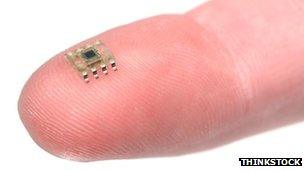Viewpoint: Why wireless can create traffic-free roads
- Published

Promises of car-free motorways may be delayed by wireless technology restrictions
The executive chairman of Ford, Bill Ford Jr, recently set out a vision of a world mostly free of traffic congestion as intelligent systems watched over traffic flow and directed vehicles accordingly.
A world where each parking space is monitored and cars directed to specific empty slots as they enter a city.
For all those sitting on the M25 yet again or driving round and round a multi-storey car park this may seem fantasy, but in principle it is a dream we could bring about.
Monitoring traffic flow is relatively easy, as is deducing where congestion is occurring and working out where to reroute cars.
But there is a big piece missing from the puzzle at the moment - a way to get information from sensors to control centres and from control centres back to cars, traffic lights, roadside signage and more.
Cost concerns
Wireless connectivity is the only viable solution. For moving vehicles this is obviously so, but even for sensors such as those on bridges or embedded into car-parking spaces, the cost of running wires to each one would be prohibitive.
In a world of the iPhone and mobile broadband it is easy to imagine this connectivity problem is solved.
It isn't. A mobile broadband connection into each car-parking space would be very expensive both in terms of the electronics needed and the cellular subscription to be paid.
Batteries would need changing far too often to be viable. And all those sensors would load the cellular networks to such a level that there would be no capacity left for people to access Facebook.
Mobile networks are great for people but terrible for machines.
The needs and applications are so different that trying to use one network for both is like combining goods trains with passenger expresses.
In fact, the reason we don't yet have a congestion-free world is that we don't have a wireless network designed for sensors, traffic lights, or more generally "machines".
Sleep mode
Such a network would share many characteristics with mobile networks.
It would consist of base stations located across the country, providing coverage everywhere - ideally better than today's cellular networks.
Wireless chips, embedded in machines, would "talk" to these base stations and messages would be routed across networks to control centres.
But the wireless technology would be quite different. It would deliberately use much lower data rates than mobile broadband in order to allow greater range, simpler and cheaper chip sets and longer battery life.

Prof Webb says there is a need to develop a new wireless network
It would be optimised for large numbers of short messages sent intermittently rather than rapid connection and multi-media download.
It would allow machines to "sleep" for much of the time to conserve their batteries for up to 10 years.
It would require only low-power transmitters to keep the cost of a chip set to about £1. It would allow for broadcast messages to groups of machines, such as all traffic lights in a city.
If we had such a network we could embed wireless connectivity everywhere - not just in cars, parking spaces and traffic lights, but in electricity meters, heart-rate monitors, cat collars, washing machines… the list is endless.
Finding spectrum
To date such a network has not emerged due to a combination of a lack of vision and a lack of radio spectrum.
Spectrum is a rarely mentioned necessity for all wireless communications, although occasionally it makes the headlines, as in 2000 when a chunk of cellular spectrum was sold in the UK for £22bn.
Spectrum comes in different shapes and sizes (well, different frequencies and bandwidths, to be precise) and a machine system needs spectrum with very particular characteristics.
It needs spectrum where radio signals travel far, where there is enough capacity for perhaps one billion devices in the UK alone, and crucially spectrum that is much less expensive than £22bn because car park sensors won't pay as much per month as iPhone users.
Only recently has some spectrum that fits these characteristics been found, and work is still under way in the UK to make it available for commercial use.
'Weightless' wireless
Based on this, engineers in my company and others, many belonging to institutions such as the IEEE (Institute of Electrical and Electronics Engineers), have got together to develop a standardised technology that will work well with the spectrum identified - "white space spectrum" - and be optimal for machines.

Tiny microcontrollers could spread the internet to a much wider range of devices
This technology is called "Weightless" although if all goes to plan you may never hear about it.
We expect Weightless chips to fall rapidly to around £1 each, to be embedded everywhere and for nationwide and indeed global networks to be deployed from 2013 onwards.
Weightless chips will communicate behind the scenes with networks, databases and control centres making things work better - traffic will flow well, meters will be read automatically and washing machines will be able to send your smartphone a message telling you their outlet pipe is getting blocked.
So when your car journey to work becomes congestion-free you'll know that it is "wait-less" because of a standard called "Weightless". It might just change our world.
Professor William Webb is a Fellow of the IEEE and the chief technology officer of Neul, one of the companies behind the Weightless standard. He is the author of the recently published book Understanding Weightless.
- Published13 March 2012
- Published10 October 2011
- Published30 September 2011